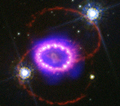Speaker
Dr
Stephen C.-Y. Ng
(McGill University)
Description
Being the brightest supernova since the invention of modern telescopes, SN 1987A has
been intensively studied over the last two decades and it exhibited a highly unusual
evolution. At radio frequencies, the initial outburst peaked on day 4 then followed
by a rapid decay. The radio emission re-emerged around mid-1990, marking the birth of
a radio remnant. Monitoring observations with the Australia Telescope Compact Array
indicate an initial remnant expansion rate over 0.1c, then slowed down to 4000km/s
before 1992 and stayed nearly constant. Over the past 12 years, the radio flux has
been increasing exponentially with a progressively flattening spectrum. The radio
remnant is now bright enough that allows the first VLBI detection recently, which
shows evidence of small-scale structure < 0.2", but still no sign of any compact
object at the center.
Primary author
Dr
Stephen C.-Y. Ng
(McGill University)
Co-authors
Dr
Anastasios Tzioumis
(Australia Telescope National Facility)
Prof.
Bryan Gaensler
(The University of Sydney)
Ms
Giovanna Zanardo
(University of Western Australia)
Prof.
Lister Staveley-smith
(University of Western Australia)
Prof.
Steven Tingay
(Curtin University)
Mr
Toby Potter
(University of Western Australia)

